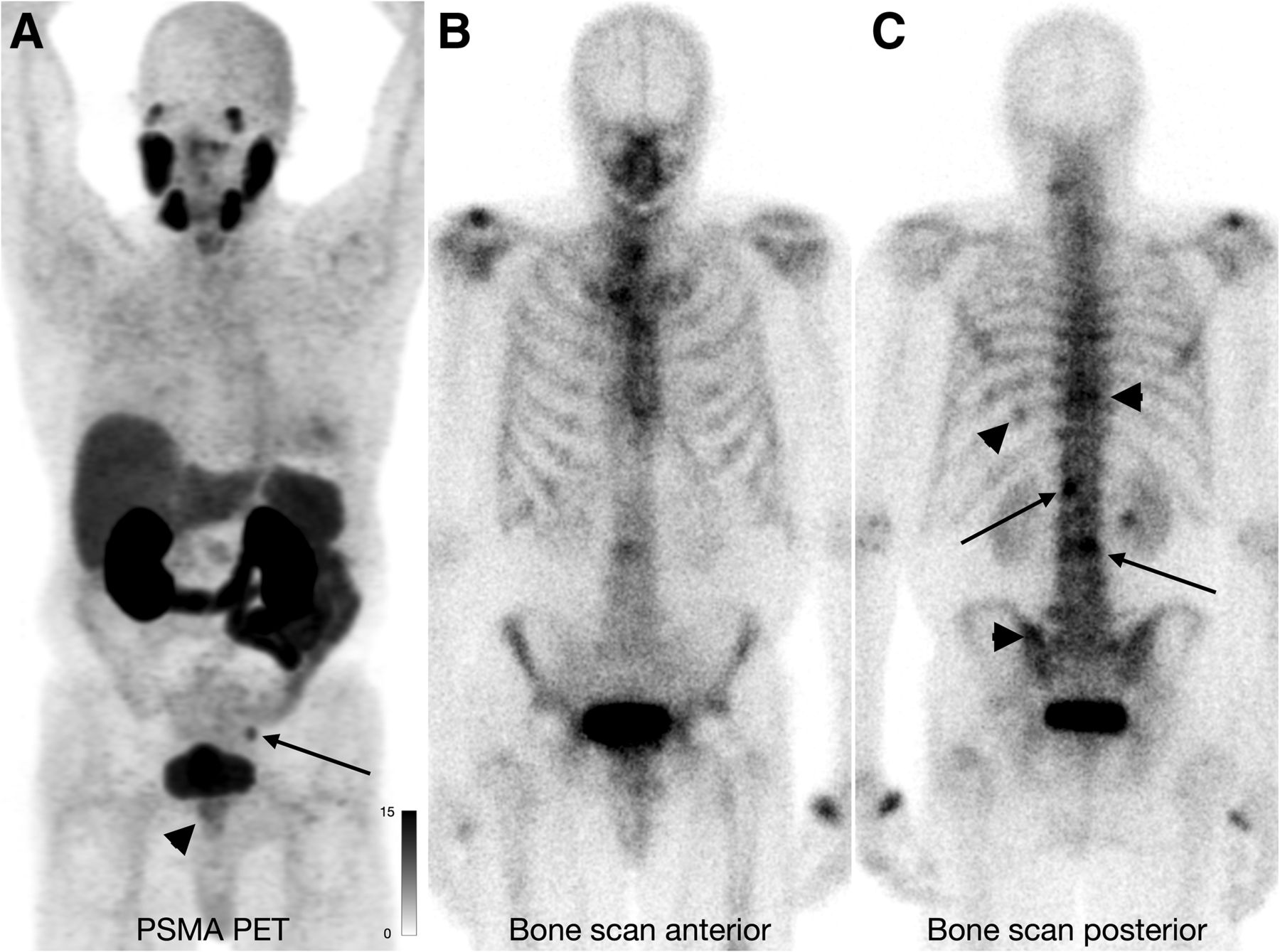A recent study reaffirms doubts about the accuracy of bone scans for initial staging of prostate cancer.
For the multicenter comparative study, published in the Journal of Nuclear Medicine, researchers assessed the use of bone scans versus a reference standard of prostate-specific membrane antigen positron emission tomography (PSMA PET) in 167 patients with prostate cancer. The cohort was comprised of 77 patients at the initial staging phase, 30 patients who had castration-resistant prostate cancer (CRPCa) and 60 patients with biochemical recurrence of CRPCa, according to the study.1
The study authors found that bone scans overall demonstrated a 73 percent positive predictive value (PPV), an 82 percent negative predictive value (NPV) and an 82 percent specificity for osseous metastases.1
While the ability of bone scans to detect osseous metastases at initial staging was associated with higher NPV at 94 percent and slightly lower specificity at 80 percent, researchers noted a significantly lower PPV at 43 percent.1
“Although one typically thinks of bone scans as understaging disease relative to PSMA PET (as was shown in our study because more lesions than on bone scans were seen in patients with positive PSMA PET scans), in the initial staging setting, a bone scan over-stages patients relative to PSMA PET because of its high false-positive rate,” wrote lead study author Thomas A. Hope, M.D., the Vice Chair of Clinical Operations and Strategy, and Director of Molecular Therapy in the Department of Radiology and Biomedical Imaging at the University of California, San Francisco, and colleagues.
The study authors noted that recent research found that a combination of docetaxel, androgen-deprivation therapy and prostate bed radiation therapy was beneficial for patients deemed to have low-volume prostate cancer.2
Three Key Takeaways
- Bone scans may have limited accuracy in initial staging of prostate cancer. The study highlights doubts about the accuracy of bone scans for the initial staging of prostate cancer. While bone scans demonstrated an 82 percent negative predictive value (NPV) for osseous metastases at initial staging, the positive predictive value (PPV) was significantly lower at 43 percent. This suggests that bone scans may over-stage patients in the initial staging setting due to a high false-positive rate.
- PSMA PET imaging offers improved accuracy. The study suggests that prostate-specific membrane antigen positron emission tomography (PSMA PET) may be a more accurate imaging modality compared to bone scans, especially for initial staging. PSMA PET showed a higher sensitivity for detecting osseous metastases, as evidenced by more lesions detected in patients with positive PSMA PET scans compared to bone scans.
- Clinical implications for treatment decisions. The study authors discuss the potential impact of misclassification on treatment decisions. They note that patients with low-volume prostate cancer, as diagnosed by bone scans, may be incorrectly classified as having metastatic disease. This misclassification could lead to unnecessary treatment with more aggressive approaches, such as radiation therapy, potentially influencing overall survival outcomes. Therefore, the study suggests a need for more accurate imaging modalities, such as PSMA PET, to avoid misclassifications and guide appropriate treatment strategies.
However, Hope and colleagues noted that extrapolation of their findings with initial staging to the cohort of the other trial may have resulted in the PSMA PET diagnosis of localized disease in 57 percent of patients diagnosed with low-volume disease (three or fewer lesions) on bone scans.1
“Therefore, there is a greater likelihood that the overall survival benefit seen in this trial is not driven by preventing further development of metastatic disease but rather by providing definitive (radiation therapy) to non-metastatic disease that was incorrectly classified as M1 by bone scanning,” pointed out Hope and colleagues.
(Editor’s note: For related content, see “Traditional Imaging Modalities Used for Prostate Cancer,” “Could a New PSMA PET Agent Improve Detection of Distant Metastatic Lesions in Patients with Prostate Cancer?” and “Multicenter PET Study Examines Bone-Only Metastasis in Patients with Castration-Resistant Prostate Cancer.”)
In regard to study limitations, the researchers noted that in light of the false positives that can occur with assessing bone lesions on PSMA PET scans, evaluating bone scans with PSMA as a reference standard may be challenging. They also acknowledged the bone scans and PSMA PET scans assessed in the study were not concurrent
References
1. Hope TA, Benz M, Jiang F, et al. Do bone scans overstage disease compared with PSMA PET at initial staging? An international multicenter retrospective study with masked independent readers. J Nucl Med. 2023;64(11):1744-1747.
2. Ali A, Hoyle A, Haran AM, et al. Association of bone metastatic burden with survival benefit from prostate radiotherapy in patients with newly diagnosed metastatic prostate cancer: a secondary analysis of a randomized clinical trial. JAMA Oncol. 2021;7(4):555-563.
